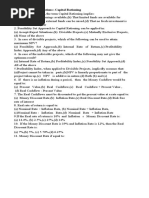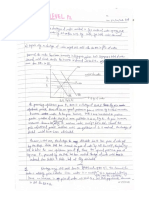0 ratings0% found this document useful (0 votes)
9 viewsHSMC
Uploaded by
ankitasahasaha008Copyright
© © All Rights Reserved
Available Formats
Download as PDF, TXT or read online on Scribd
0 ratings0% found this document useful (0 votes)
9 viewsHSMC
Uploaded by
ankitasahasaha008Copyright
© © All Rights Reserved
Available Formats
Download as PDF, TXT or read online on Scribd
You are on page 1/ 8
what is elasticity of demand
Elasticity of demand measures how sensitive the quantity demanded of a good or
service is to a change in its price. It is a concept in economics that helps understand
the relationship between price changes and consumer behavior. There are several
types of demand elasticity, but the most common is price elasticity of demand.
Price Elasticity of Demand (PED)
Price elasticity of demand (PED) is defined as the percentage change in quantity
demanded divided by the percentage change in price. The formula is:
PED=% change in quantity demanded% change in pricePED=% change in price% chan
ge in quantity demanded
Depending on the value of PED, demand can be classified as:
Elastic Demand (PED > 1): A small change in price leads to a large change in
quantity demanded. Consumers are highly responsive to price changes.
Inelastic Demand (PED < 1): A change in price leads to a relatively small
change in quantity demanded. Consumers are not very responsive to price
changes.
Unitary Elastic Demand (PED = 1): The percentage change in quantity
demanded is equal to the percentage change in price.
Factors Affecting Price Elasticity of Demand
Several factors influence the price elasticity of demand for a product:
1. Availability of Substitutes: Goods with many close substitutes tend to have
more elastic demand because consumers can easily switch to alternatives if
the price rises.
2. Necessity vs. Luxury: Necessities tend to have inelastic demand, while luxuries
are more elastic.
3. Proportion of Income: If a good takes up a large portion of a consumer’s
income, its demand tends to be more elastic.
4. Time Period: Demand elasticity can vary over time. Generally, demand is more
elastic in the long run because consumers have more time to adjust their
behavior.
Other Types of Elasticity of Demand
Income Elasticity of Demand (YED): Measures how quantity demanded
changes in response to changes in consumer income.
YED=% change in quantity demanded% change in incomeYED=% change in income% c
hange in quantity demanded
Positive YED indicates a normal good (demand increases with income).
Negative YED indicates an inferior good (demand decreases as income
rises).
Cross Elasticity of Demand (XED): Measures how the quantity demanded of
one good changes in response to a change in the price of another good.
XED=% change in quantity demanded of Good A% change in price of Good BXED=% c
hange in price of Good B% change in quantity demanded of Good A
Positive XED indicates substitute goods.
Negative XED indicates complementary goods.
what is opportunity cost
Opportunity cost is an economic concept that refers to the value of the next best
alternative that is forgone when a decision is made to pursue a particular action. It
represents the benefits that could have been obtained by choosing the alternative
option. This concept is crucial in decision-making processes because it highlights the
potential trade-offs involved in any economic choice.
Key Aspects of Opportunity Cost
1. Choice and Scarcity: Since resources (time, money, effort, etc.) are limited,
individuals and organizations must make choices about how to allocate them.
Opportunity cost arises from the need to choose one option over another.
2. Relative Value: Opportunity cost is not just about the monetary cost but also
the relative value of what is given up. For instance, if you spend time working
on a project, the opportunity cost is the leisure time or other activities you
could have enjoyed instead.
3. Implicit and Explicit Costs: Opportunity cost includes both explicit costs (direct
monetary expenses) and implicit costs (non-monetary costs such as time,
effort, and foregone opportunities).
Examples of Opportunity Cost
Education: The opportunity cost of attending college includes not only the
tuition fees and other expenses but also the income you could have earned if
you had worked instead of studying.
Investments: If you decide to invest in stocks, the opportunity cost is the
potential returns you could have earned from an alternative investment, such
as bonds or real estate.
Business Decisions: A company might face a decision about whether to invest
in new technology or expand its workforce. The opportunity cost of choosing
new technology is the benefits that additional employees might have brought
to the business, and vice versa.
Importance of Opportunity Cost
1. Resource Allocation: Understanding opportunity costs helps individuals and
businesses allocate their resources more efficiently. By considering what they
are giving up, they can make more informed choices that maximize their
benefits.
2. Cost-Benefit Analysis: It plays a crucial role in cost-benefit analysis, helping to
weigh the potential benefits of different choices against their opportunity
costs to make the most advantageous decision.
3. Policy Making: Governments and policymakers use the concept of opportunity
cost to evaluate the potential benefits of different policy options. For example,
when deciding whether to spend money on healthcare or education,
understanding the opportunity cost of each option can lead to better policy
decisions.
Calculating Opportunity Cost
While opportunity cost is often conceptual, it can sometimes be quantified. The basic
formula is:
Opportunity Cost=Return on Best Foregone Option−Return on Chosen OptionOpport
unity Cost=Return on Best Foregone Option−Return on Chosen Option
explain marginal costing
Marginal costing, also known as variable costing or direct costing, is an accounting
method in which only variable costs are considered when calculating the cost of
producing additional units of a product. This method focuses on the cost behavior
and distinguishes between fixed and variable costs to aid in decision-making
processes.
Key Concepts of Marginal Costing
1. Variable Costs: These are costs that change in direct proportion to changes in
production volume. Examples include raw materials, direct labor, and variable
manufacturing overheads.
2. Fixed Costs: These are costs that remain constant regardless of the production
volume within a certain range. Examples include rent, salaries, and
depreciation.
3. Contribution Margin: This is the difference between sales revenue and
variable costs. It is calculated as:
Contribution Margin=Sales Revenue−Variable CostsContribution Margin=Sales Reven
ue−Variable Costs
The contribution margin contributes to covering fixed costs and generating profit.
4. Marginal Cost: This is the cost of producing one additional unit of a product. It
includes only variable costs.
Benefits of Marginal Costing
1. Simple and Clear: By focusing only on variable costs, marginal costing provides
a straightforward way to understand the impact of production changes on
costs and profitability.
2. Decision-Making: It aids in various short-term decision-making processes such
as pricing, determining optimal production levels, and deciding whether to
accept special orders.
3. Break-Even Analysis: Marginal costing facilitates break-even analysis by
helping to calculate the break-even point, where total revenue equals total
costs, and no profit or loss is made. The break-even point is calculated as:
Break-Even Point (Units)=Total Fixed CostsContribution Margin per UnitBreak-
Even Point (Units)=Contribution Margin per UnitTotal Fixed Costs
4. Cost Control: It helps in identifying and controlling variable costs, thereby
enabling more efficient resource allocation.
Applications of Marginal Costing
1. Pricing Decisions: Marginal costing helps in setting prices by ensuring that
variable costs are covered and that contribution margin is maximized. This is
particularly useful in competitive markets where prices need to be set
strategically.
2. Profit Planning: By analyzing the impact of changes in production volume on
costs and profitability, businesses can plan for different levels of output and
their corresponding profit levels.
3. Make or Buy Decisions: Businesses can decide whether to produce a
component in-house or purchase it from an external supplier by comparing
the marginal cost of production with the purchase price.
4. Product Mix Decisions: When a company produces multiple products,
marginal costing helps in deciding the optimal product mix that maximizes
overall profitability.
what is meant by marginal revenue
Marginal revenue is the additional revenue that a firm earns when it sells one more
unit of a product. It is a crucial concept in economics and business decision-making,
particularly in the context of pricing, production, and profit maximization.
Key Aspects of Marginal Revenue
1. Definition: Marginal revenue (MR) is calculated as the change in total revenue
(TR) that results from selling one additional unit of a product. The formula for
marginal revenue is:
Marginal Revenue (MR)=ΔTotal RevenueΔQuantityMarginal Revenue (MR)=ΔQuantity
ΔTotal Revenue
where ΔΔ denotes the change in the respective variables.
2. Relationship to Total Revenue: Total revenue is the total income a firm
receives from selling its goods or services. It is calculated as:
Total Revenue (TR)=Price (P)×Quantity (Q)Total Revenue (TR)=Price (P)×Quantity (Q)
Marginal revenue indicates how total revenue changes as the quantity sold changes.
3. Demand Curve and Marginal Revenue:
In a perfectly competitive market, the demand curve is perfectly elastic
(horizontal), meaning the price does not change with the quantity sold.
Therefore, marginal revenue equals the price of the product.
In a monopolistic or imperfectly competitive market, the demand curve
slopes downward, meaning the price decreases as the quantity sold
increases. Here, marginal revenue decreases with each additional unit
sold and is always less than the price of the product.
Marginal Revenue in Different Market Structures
1. Perfect Competition:
Firms are price takers and can sell any quantity at the market price.
Marginal revenue (MR) is constant and equal to the price (P).
MR=PMR=P
2. Monopoly:
A single firm controls the market and faces the downward-sloping
market demand curve.
To sell more units, the firm must lower the price, which affects the
revenue from all units sold.
Marginal revenue decreases as quantity increases and is less than the
price.
MR<PMR<P
3. Monopolistic Competition and Oligopoly:
Firms have some degree of market power and face downward-sloping
demand curves.
Marginal revenue decreases with increased quantity but not as steeply
as in a pure monopoly.
Importance of Marginal Revenue
1. Profit Maximization: Firms maximize profit by producing up to the point
where marginal revenue equals marginal cost (MR = MC). Beyond this point,
the cost of producing an additional unit exceeds the revenue gained from its
sale, reducing overall profit.
2. Pricing Strategy: Understanding marginal revenue helps firms set optimal
prices. For instance, in a monopoly, the firm can determine the price-quantity
combination that maximizes total revenue and profit.
3. Output Decisions: Marginal revenue guides firms in deciding the quantity of
output to produce. By comparing MR to marginal cost (MC), firms can
determine the most profitable level of production.
define term "depreciation"
Depreciation is an accounting method used to allocate the cost of a tangible asset
over its useful life. It represents the decrease in the value of an asset over time due
to factors such as wear and tear, age, and obsolescence. Depreciation allows
businesses to spread out the expense associated with an asset, rather than
accounting for the entire cost in the year of purchase.
Key Concepts of Depreciation
1. Tangible Assets: Depreciation applies to physical assets such as machinery,
vehicles, buildings, and equipment. It does not apply to intangible assets (e.g.,
patents, trademarks) or land, which typically does not depreciate.
2. Useful Life: This is the estimated period over which the asset is expected to be
used by the business. The useful life varies depending on the type of asset and
its expected usage.
3. Salvage Value: Also known as residual value, this is the estimated value of the
asset at the end of its useful life. It is the amount the company expects to
recover upon disposal of the asset.
4. Depreciable Base: This is the cost of the asset minus its salvage value. It
represents the total amount that will be depreciated over the asset’s useful
life.
Depreciable Base=Cost of Asset−Salvage ValueDepreciable Base=Cost of Asset−Salvag
e Value
Methods of Depreciation
1. Straight-Line Method: This method spreads the depreciable base evenly over
the useful life of the asset. It is calculated as:
Annual Depreciation Expense=Depreciable BaseUseful LifeAnnual Depreciation Expen
se=Useful LifeDepreciable Base
2. Declining Balance Method: This method applies a constant depreciation rate
to the declining book value of the asset each year. The double-declining
balance method is a common version, calculated as:
Depreciation Expense=2×Straight-
Line Rate×Book Value at Beginning of YearDepreciation Expense=2×Straight-
Line Rate×Book Value at Beginning of Year
3. Units of Production Method: Depreciation is based on the asset’s usage,
activity, or units produced. It is calculated as:
Depreciation Expense=(Cost of Asset−Salvage ValueTotal Estimated Units of Productio
n)×Units Produced in PeriodDepreciation Expense=(Total Estimated Units of Producti
onCost of Asset−Salvage Value)×Units Produced in Period
4. Sum-of-the-Years'-Digits Method: This method accelerates depreciation by
multiplying the depreciable base by a fraction that decreases over time. The
fraction is based on the sum of the years' digits of the asset’s useful life.
Importance of Depreciation
1. Matching Principle: Depreciation ensures that the cost of an asset is matched
with the revenue it generates over its useful life, providing a more accurate
picture of a company's financial performance.
2. Tax Benefits: Depreciation is a non-cash expense that reduces taxable income,
leading to potential tax savings for businesses.
3. Financial Reporting: It helps in presenting a realistic value of assets on the
balance sheet, reflecting their decrease in value over time.
4. Investment Decisions: Understanding depreciation helps in assessing the true
cost and profitability of long-term investments in assets.
Example of Depreciation Calculation
Suppose a company buys machinery for $50,000 with an estimated useful life of 10
years and a salvage value of $5,000.
1. Depreciable Base:
Depreciable Base=$50,000−$5,000=$45,000Depreciable Base=$50,000−$5,000
=$45,000
2. Straight-Line Depreciation:
Annual Depreciation Expense=10$45,000=$4,500
You might also like
- Kazakhstan Model of Economic DevelopmentNo ratings yetKazakhstan Model of Economic Development5 pages
- Managerial Economics Notes 2024 - 055653No ratings yetManagerial Economics Notes 2024 - 05565322 pages
- Ae11 Reviewer Midterm Exam For DistributionNo ratings yetAe11 Reviewer Midterm Exam For Distribution6 pages
- Demand forecasting is a crucial aspect of businessNo ratings yetDemand forecasting is a crucial aspect of business8 pages
- Fundamental Concept of Managerial EconomicsNo ratings yetFundamental Concept of Managerial Economics3 pages
- Business Economics: Q1. Calculate The FollowingNo ratings yetBusiness Economics: Q1. Calculate The Following10 pages
- Economic Principles Assist in Rational Reasoning and Defined ThinkingNo ratings yetEconomic Principles Assist in Rational Reasoning and Defined Thinking3 pages
- ASSIGNMENT (Business Economic) : Aryan Goyal 18/FCBS/BBA (G) IB/003 Opportunity CostNo ratings yetASSIGNMENT (Business Economic) : Aryan Goyal 18/FCBS/BBA (G) IB/003 Opportunity Cost5 pages
- A Review in Managerial Economics: Prepared By: Jeams E. VidalNo ratings yetA Review in Managerial Economics: Prepared By: Jeams E. Vidal8 pages
- BA 210 MANAGERIAL ECONOMICS - Module 5 - Balin, LNo ratings yetBA 210 MANAGERIAL ECONOMICS - Module 5 - Balin, L26 pages
- Unit-IV Cost and Revenue analysis_protected_unlockedNo ratings yetUnit-IV Cost and Revenue analysis_protected_unlocked67 pages
- MG 2452 Engineering Economics and Financial AccountingNo ratings yetMG 2452 Engineering Economics and Financial Accounting16 pages
- Cost Terms, Concepts, and Classifications: Instructor: Rabia UmerNo ratings yetCost Terms, Concepts, and Classifications: Instructor: Rabia Umer18 pages
- Economic Analysis For Business Decisions 103No ratings yetEconomic Analysis For Business Decisions 10331 pages
- Principles of Business Decisions - SEction INo ratings yetPrinciples of Business Decisions - SEction I4 pages
- Management Accounting: Business Strategy & Performance: Decision-Making by NumbersFrom EverandManagement Accounting: Business Strategy & Performance: Decision-Making by NumbersNo ratings yet
- Lexicon of Economic Terminology: Lexicon of Tech and Business, #13From EverandLexicon of Economic Terminology: Lexicon of Tech and Business, #135/5 (1)
- Financial Indicators of Vardhman Group (Rs. in Crores)No ratings yetFinancial Indicators of Vardhman Group (Rs. in Crores)4 pages
- Kidde ECS 500 Psi With FK-5-1-12 Fire Protection Fluid Supervisory Pressure Switch K-45-0514No ratings yetKidde ECS 500 Psi With FK-5-1-12 Fire Protection Fluid Supervisory Pressure Switch K-45-05141 page
- GST Chapter 3 Levy and Collection Part 2No ratings yetGST Chapter 3 Levy and Collection Part 217 pages
- Assignment 3 Business Economics Sweet Potato Case50% (2)Assignment 3 Business Economics Sweet Potato Case7 pages
- Approval Document ASSET DOC LOC 3057682 Hilti BlockNo ratings yetApproval Document ASSET DOC LOC 3057682 Hilti Block15 pages
- Advanced Econometrics Assignment 2 Due Date: November 10, 2017, 11.59 PMNo ratings yetAdvanced Econometrics Assignment 2 Due Date: November 10, 2017, 11.59 PM1 page
- BTi Ausschnitt Katalog BT-Spannschloss R en WebNo ratings yetBTi Ausschnitt Katalog BT-Spannschloss R en Web10 pages
- Application of CVP (Break-Even) AnalysisNo ratings yetApplication of CVP (Break-Even) Analysis15 pages
- Demand forecasting is a crucial aspect of businessDemand forecasting is a crucial aspect of business
- Economic Principles Assist in Rational Reasoning and Defined ThinkingEconomic Principles Assist in Rational Reasoning and Defined Thinking
- ASSIGNMENT (Business Economic) : Aryan Goyal 18/FCBS/BBA (G) IB/003 Opportunity CostASSIGNMENT (Business Economic) : Aryan Goyal 18/FCBS/BBA (G) IB/003 Opportunity Cost
- A Review in Managerial Economics: Prepared By: Jeams E. VidalA Review in Managerial Economics: Prepared By: Jeams E. Vidal
- Unit-IV Cost and Revenue analysis_protected_unlockedUnit-IV Cost and Revenue analysis_protected_unlocked
- MG 2452 Engineering Economics and Financial AccountingMG 2452 Engineering Economics and Financial Accounting
- Cost Terms, Concepts, and Classifications: Instructor: Rabia UmerCost Terms, Concepts, and Classifications: Instructor: Rabia Umer
- Management Accounting: Business Strategy & Performance: Decision-Making by NumbersFrom EverandManagement Accounting: Business Strategy & Performance: Decision-Making by Numbers
- Lexicon of Economic Terminology: Lexicon of Tech and Business, #13From EverandLexicon of Economic Terminology: Lexicon of Tech and Business, #13
- Pricing Types: Signalling Market Positioning IntentFrom EverandPricing Types: Signalling Market Positioning Intent
- Financial Indicators of Vardhman Group (Rs. in Crores)Financial Indicators of Vardhman Group (Rs. in Crores)
- Kidde ECS 500 Psi With FK-5-1-12 Fire Protection Fluid Supervisory Pressure Switch K-45-0514Kidde ECS 500 Psi With FK-5-1-12 Fire Protection Fluid Supervisory Pressure Switch K-45-0514
- Approval Document ASSET DOC LOC 3057682 Hilti BlockApproval Document ASSET DOC LOC 3057682 Hilti Block
- Advanced Econometrics Assignment 2 Due Date: November 10, 2017, 11.59 PMAdvanced Econometrics Assignment 2 Due Date: November 10, 2017, 11.59 PM

























































































